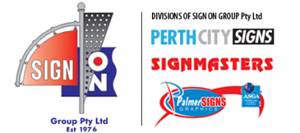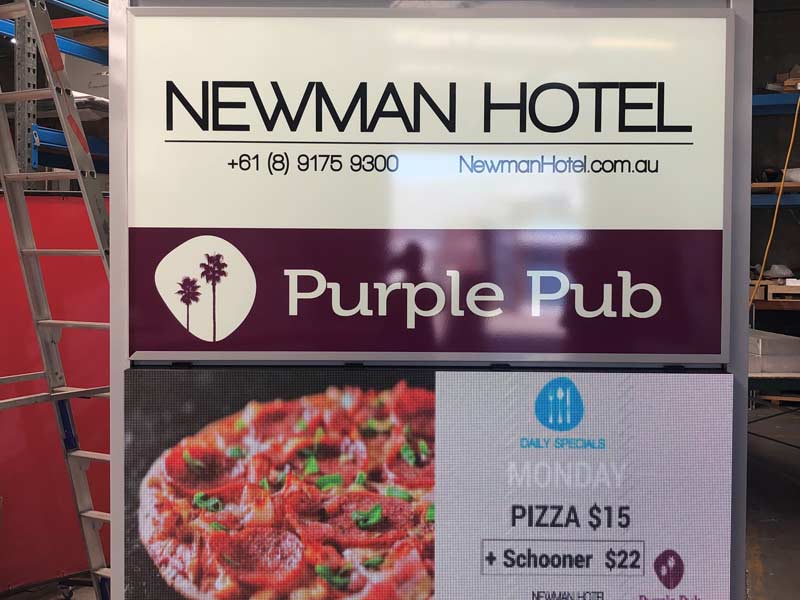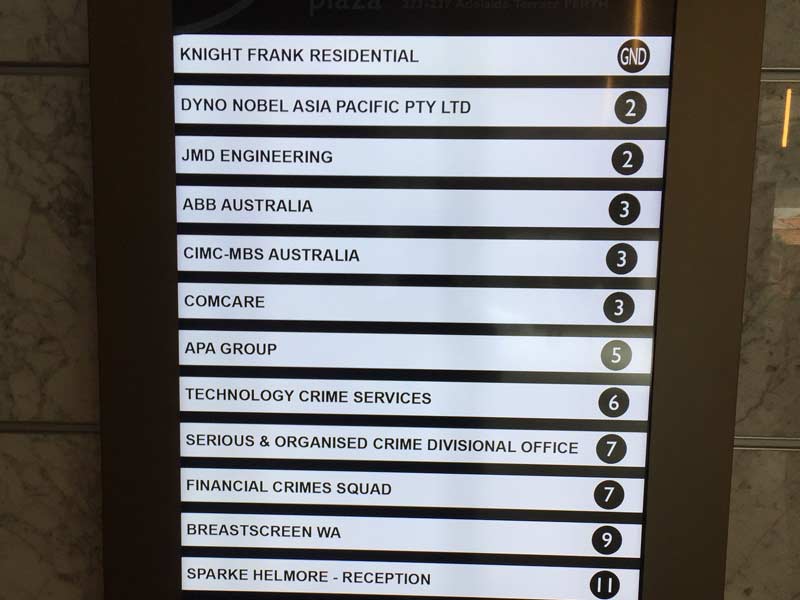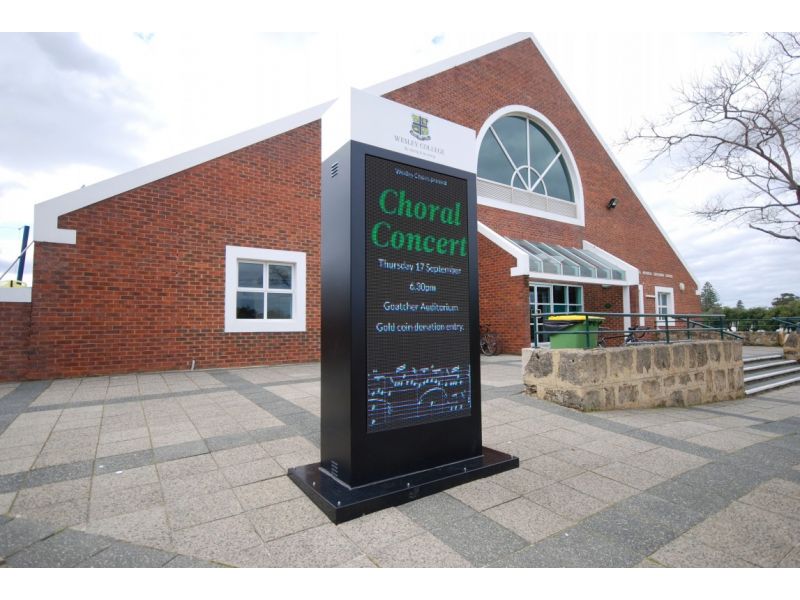Our Signage Showcase

Real Estate Signs






Digital Signs! What you need to know.
What is Digital Signage?
By definition, Digital signage is a name given to any number of methods used to display multimedia content in public venues. Alternatively known as dynamic signage, electronic signage or narrowcasting, networks of digital signs have been deployed across numerous retail chains, banks, travel hubs and corporate headquarters to deliver informative and entertaining content to captive audiences and passers-by. In its most basic implementation, a digital sign consists of a playback device (such as a computer, VCR or DVD player) connected to a display. Depending on the application, the display might be a small LCD screen, a plasma display panel, or even a video wall composed of a number of connected screens. With a number of affordable options available, anybody with a message to send to their out-of-home audience can benefit from a digital signage installation.
The History Of Digital Signs.
The concept of out-of-home messages is not new. Billboards, window treatments and point-of-purchase displays are widely used for out-of-home advertising, while bulletin boards (both traditional and electronic), flyers, faxes, memos, and email have been used to send corporate communications and educate employees for decades. However, true dynamic signs first came into popular use with the advent of in-store closed-circuit television networks in the 1970s. With the widespread availability of affordable VCRs, retail stores and corporate headquarters were able to play back pre-recorded content to their patrons and employees, providing timely information and entertaining content. Soon, closed circuit networks would be augmented (and in some cases, supplanted) with affordable TV/VCR combination units for smaller displays, and projection screens and video walls for eye-catching, large format presentations. With satellite distribution, it even became (relatively) affordable to syndicate the same content to thousands of sites at once.
Modern Digital Signs
In recent years, several factors have combined to make digital a more powerful, eye-catching, and affordable display medium than ever before contributing to its widespread adoption. Key factors include the nearly ubiquitous availability of high-speed Internet access, new large format displays like plasma screens and LCD panels, and new compression formats that can compress large amounts of content into small file sizes. A modern digital sign adds several additional components to the traditional setup described above. The controller, typically a powerful computer or media playback appliance, use a digital connection to deliver a crisp output signal to a digital display, like a plasma screen or LCD panel. The playback device uses a digital storage medium (such as a hard drive or solid- state flash disk) to store digital content locally, ensuring smooth playback. In many cases, the device can be remotely managed over the Internet to allow for content updates, schedule changes, and compliance reporting.
Even the smallest digital sign networks can benefit from remote management. Aside from offsetting the costs of producing, replicating and distributing VHS tapes or DVDs, Internet-connected signage devices provide network administrators with the ability to closely monitor playback, ensuring that the desired content is being displayed. Delivering content over the Internet ensures that the content arrives and is displayed according to the proper schedule, eliminates errors in shipping and handling, and removes reliance upon on-site personnel to change tapes or DVDs (since these individuals are typically not very motivated to perform such tasks). Additionally, compliance reporting gives network owners a complete record of what every screen has displayed. Finally, user-friendly management tools mean that people throughout the organization – from advertising and creative services to operations and general management – are empowered to change content and generate reporting metrics. More sophisticated remote management suites also give network operators the ability to perform near real-time adjustments to every display’s playback schedule, enabling real-time marketing experiments, emergency announcements, and even live content feeds.
What Kind of Digital Signage should you use
Choosing the right digital signage technology depends on the intended application. For example, a digital signage application for internal corporate communications would probably benefit from large, eye-catching plasma displays placed in common areas such as cafeterias and break rooms. Depending on the size of the deployment, the network owner might opt for either local or remote management. On the other end of the spectrum, a manufacturer looking to improve their point-of-purchase advertising displays might choose to employ small, lightweight LCD panels in conjunction with traditional product displays in an aisle or endcap fixture, managing the content centrally via a web-based interface.
Of course, budget constraints must also be taken into consideration. Digital signage applications that require large displays have a number of options to choose from, including rear projection TVs, LCDs, plasmas, DLPs, wall projectors, and traditional CRTs. Smaller signs are typically either small LCD or CRT displays. Touchscreens are available for virtually any sized display and can add an interactive component to an otherwise non-interactive display medium.
Finally, though many digital sign networks start modestly, it is important to plan for the future. A network of a few screens may be easy to manage by shipping and swapping DVDs. However, if that network grows to 25, 50 or 100 screens, this type of content management becomes much more cumbersome. Additionally, features that may not seem relevant during the early stages of a deployment might prove to be essential later on. For example, the ability to add or delete a piece of content on short notice might not seem important to a small sign network owner until the necessity arises, often at the insistence of a large advertiser. Similarly, other business opportunities may rely on advanced features like real-time scheduling or live content insertions. What’s more, the availability of turnkey, hosted digital signage software can actually make it cheaper to deploy the initial systems with full remote management capability – providing a solution that is affordable for today and scalable for tomorrow.
Who can use digital Signage?
Anybody who needs to display dynamic content in a public environment can benefit from digital signs. While retailers are arguably adopting signage networks in the largest numbers, the technology is also being used to deliver dynamic messages to customers and employees alike in financial institutions, travel hubs, auto dealerships, corporate offices, and other venues. Consider the following examples:
Instore Advertising:
A retail store chain looking to provide product manufacturers with an additional form of in-store advertising works with an outside ad agency to place targeted promotions across a network of screens. By outsourcing the ad sales to a professional organization, the store chain can continue to focus on its core competencies while helping to ensure that the ads will be sold, displayed and tracked for compliance (proof-of-playback). In this scenario, the retailer can utilize various metrics to determine the effect of the dynamic media on product sales – especially when the digital signage software makes it possible to run different campaigns at each store. Integrating the digital signage network into an existing co-op program can also prove lucrative for the store and vendors alike.
Staff Education and Live Television Feed: A chain of regional banks wants to educate its employees on new products and services on a weekly basis, and also provide advertising content and a live television feed to patrons during business hours. The bank works with a digital signage consultant to assemble the network and supply it with content. The consultant works with the bank to create the product information spots, which appear onscreen before business hours for employee education. At the start of the business day, the network is configured to divide the screen into two areas, supply one of them with custom advertising content supplied by the bank, and tune a local news station to the other.
Remote Manufacturing Facility Updates Information: A corporation with a national headquarters and several remote manufacturing facilities wants to provide employees with up-to-the-minute industry news, information on upcoming holidays and company-sponsored events, as well as a weekly address from the CEO. Using a centrally managed digital signage architecture, a network administrator at the home office can schedule each of these items ahead of time, and provide customized schedules for each facility.
Partner With Us For Your Digital Sign Project Success
When embarking on a digital sign project, you may wish to consult with firms that provide key services in various areas. For instance, financing companies can help spread the up-front expense of the display hardware and infrastructure over a multi-year period, so your company only pays an affordable monthly fee. Similarly, skilled partners are available to assist in ad sales, system deployment, content authoring, and end-user support.
Signage Content Management Systems
Can I Schedule Content Delivery?
One of the great features that a quality CMS offers is the flexibility to schedule content when and where you need it. That’s an invaluable feature to have if your digital signage development spans one or more time zones or market verticals.
For retailers, this is an invaluable feature, as it allows the advertisement of sales and special offers at specific times and locations. In the transportation vertical, travel schedules can be delivered specifically to individual airports and train stations.
Can I Create Custom Content?
CMS dashboards, generally, allow for the creation of custom content whether they are delivered by a CMS template or an included app.
Some of the better CMS packages allow you to tailor your content by allowing you to choose graphics, video and news feeds. Depending on the CMS you choose, you may even be able to input local postcodes of your digital signage deployment for local weather.
How Do I Know What’s Being Displayed at Remote Locations?
A good CMS should allow you to remotely monitor the status of every display in your digital signage network as part of the software’s dashboard controls.
It should provide information as to display status, the nature of a problem (if one exists) and the ability to restart the service or display.
Reasons why digital signage is useful.
- Digital media signage eliminates the cost and waiting time compared to printing. Content can be updated at any time, and almost immediately
- It’s impressive. Digital signage attracts attention and it’s a great way to attract customers. Not only that, but people are more likely to pay attention if you are displaying promotions, information or news
- If your competitors have it, so should you!
- Digital signs allow you to generate money from advertisers, especially for places such as large shopping centres
- Digital signage can be used as a tool to interact with your customers. This can act as an extra salesperson or customer service rep when everyone else is busy – think of it as an entertainment medium whilst customers are waiting to be served
- You are in control of what is displayed. You can show and change relevant information depending on when is best for you
- It goes without saying that digital sign displays make the atmosphere livelier whilst loooking attractive. If you’re after a unique atmosphere, this may be just what you need
- Digital signage is a great way to help your marketing team as it allows you to effectively and efficiently communicate messages with your customers and your employees
- Finally, you can display anything you choose to. From news channels to twitter feeds, photographs to advertisements – the list is endless. You can put everything you need onto the same screen, at the same time.
Other Services
Our Promise
- Quality workmanship
- Experience & advice
- First class tradespeople
- First class results
- No project too big or small
Contact Us
Quick Enquiry
We are here
14 Carbon Court, Osborne Park




























